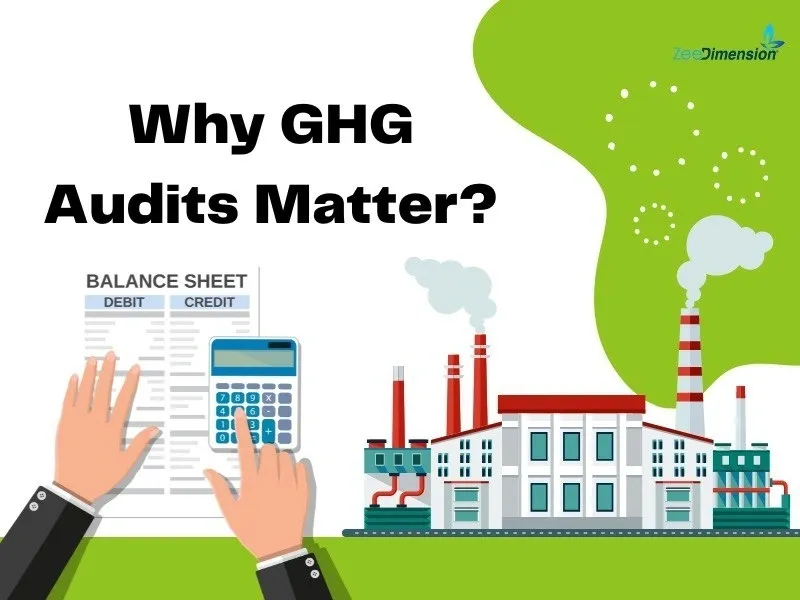
As companies shift towards prioritizing sustainability, the comprehension and control of greenhouse gas (GHG) emissions have emerged as crucial components of their environmental initiatives. While GHGs play a vital role in regulating the Earth’s temperature, human actions have notably amplified their presence, fueling global warming and climate alterations. This blog post will delve into the significance of GHGs, the importance of GHG audits for corporations, and how third-party verification guarantees precision in emissions documentation. For organizations dedicated to sustainability, GHG verification goes beyond mere adherence to regulations; it serves as a valuable asset for attaining financial, environmental, and reputational advantages.
What is GHG?
Greenhouse gases (GHGs) are atmospheric gases that trap heat, playing a key role in warming the Earth’s surface by absorbing and emitting infrared radiation. This process, known as the greenhouse effect, helps regulate the planet’s temperature. The primary GHGs include:
-
Carbon dioxide (CO₂): Generated from the burning of fossil fuels, deforestation, and industrial processes.
-
Methane (CH₄): Released during the extraction and transport of coal, oil, and natural gas, as well as from livestock and agricultural activities.
-
Nitrous oxide (N₂O): Emitted through agricultural practices, industrial operations, and burning fossil fuels and waste.
-
Fluorinated gases: Man-made gases used in various industrial applications.
While these gases are essential for maintaining Earth’s temperature, human activities have significantly increased their concentrations, contributing to global warming and climate change.
Why do GHG Audits Matter?
Environmental, Social, and Governance (ESG) factors are at the core of sustainable business practices. Among these, managing and reporting Greenhouse Gas (GHG) emissions is crucial for businesses aiming to minimize their environmental footprint. As climate change becomes a priority, companies must accurately measure, reduce, and report their GHG emissions.
The Role of Third-Party Verification:
Third-party verification involves independent audits of a company’s GHG emissions data. This ensures that the information reported is accurate, complete, and compliant with leading standards like the GHG Protocol and TCFD.
Greenhouse Gas (GHG) audits are critical for several key reasons:
📷
1- Identifying Emission Sources: GHG audits enable organizations to identify the origins of their emissions, whether from direct operations, supply chains, or product usage. This detailed insight is crucial for effectively reducing emissions.
2- Regulatory Compliance: As emissions regulations tighten globally, including the Corporate Sustainability Reporting Directive (CSRD) in the EU and the SEC’s disclosure rules in the US, GHG audits help ensure companies remain compliant with these evolving standards.
3- Financial Benefits: By uncovering inefficiencies, GHG audits can lead to cost savings through reduced energy consumption and improved operational processes, lowering overall expenses.
4- Reputation and Accountability: Organizations that perform GHG audits and transparently share their findings demonstrate a commitment to sustainability, which can enhance their reputation with stakeholders and show accountability in addressing climate change.
5- Strategic Planning: The data gathered from GHG audits supports long-term sustainability planning, helping organizations set practical and effective emission reduction goals.
6- Supporting Global Goals: GHG audits contribute to global climate efforts by helping companies reduce emissions, thereby playing a part in limiting the rise in global temperatures.
How Does GHG Verification Work?
GHG verification ensures the accuracy and credibility of an organization’s reported greenhouse gas emissions. The process involves:
-
Preparation: The organization compiles its GHG inventory, gathering data on all emissions sources based on recognized protocols like the GHG Protocol or ISO 14064.
-
Verifier Selection: An accredited, independent third-party verifier is chosen for the assessment.
-
Planning: The verifier and organization agree on the verification scope and level of assurance required.
-
Data Review: The verifier checks the GHG inventory for completeness and accuracy, reviewing the methodologies used.
-
Site Visits: If needed, the verifier visits sites to verify data at the source and interview staff.
-
Verification Report: A report is prepared, outlining any discrepancies and providing recommendations.
-
Certification: Successful verification results in a certification or statement, enhancing regulatory compliance and transparency.
This process helps organizations ensure reliable reporting and build trust with stakeholders.
Beyond GHG Audits: Comprehensive ESG Audits
Third-party verifications extend beyond GHG data to include:
1- Social Audits: Labor practices, diversity, and human rights.
2- Governance Audits: Corporate governance structures and ethical practices.
What Businesses Gain from GHG Verification?
1. Enhanced Reputation: Demonstrates commitment to sustainability.
2. Attracting Investment: Appeals to ESG-focused investors.
3. Operational Efficiency: Uncovers resource inefficiencies.
4. Competitive Advantage: Stand out in the market with verified ESG data.
In conclusion, GHG audits and verifications are integral steps in supporting broader sustainability goals and demonstrating a commitment to responsible environmental stewardship.
Ready to Elevate Your ESG Reporting?
Make sure your GHG emissions data is verified and trusted by stakeholders. Third-party verification is the path to sustainability-driven success!







